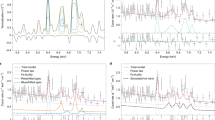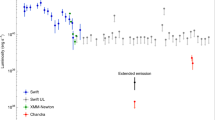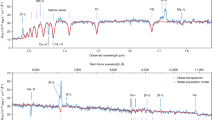Abstract
Herbig–Haro (HH) objects have been known1,2 for 50 years to be luminous condensations of gas in star-forming regions, but their underlying physical nature is still being elucidated. Previously suggested models encompass newborn stars3, stellar winds clashing with nebular material4, dense pockets of interstellar gas excited by shocks from outflows5, and interstellar ‘bullets’ (ref. 6). Recent progress has been made with the jet-induced shock model7, in which material streams out of young stellar objects and collides with the surrounding interstellar medium. A clear prediction of this model is that the most energetic Herbig–Haro objects will emit X-rays, although they have not hitherto been detected8. Here we report the discovery of X-ray emission from one of the brightest and closest Herbig–Haro objects, HH2, at a level consistent with the model predictions. We conclude that this Herbig–Haro object contains shock-heated material located at or near its leading edge with a temperature of about 106 K.
This is a preview of subscription content, access via your institution
Access options
Subscribe to this journal
Receive 51 print issues and online access
$199.00 per year
only $3.90 per issue
Buy this article
- Purchase on Springer Link
- Instant access to full article PDF
Prices may be subject to local taxes which are calculated during checkout



Similar content being viewed by others
References
Herbig, G. H. The spectra of two nebulous objects near NGC 1999. Astrophys. J. 113, 697–698 (1951).
Haro, G. Herbig's nebulous objects near NGC 1999. Astrophys. J. 115, 572–573 (1952).
Ambarzumian, V. A. Commun. Burakan Obs. 13, 3–35 (1954).
Canto, J. & Rodriguez, L. A stellar wind focusing mechanism as an explanation for Herbig–Haro objects. Astrophys. J. 239, 982–987 (1980).
Schwartz, R. D. A shocked cloudlet model for Herbig–Haro objects. Astrophys. J. 233, 884–900 (1978).
Norman, C. & Silk, J. Interstellar bullets: H2O masers and Herbig–Haro objects. Astrophys. J. 228, 197–205 (1979).
Reipurth, B. & Bertout, C. (eds) Herbig–Haro Flows and the Birth of Stars (IAU Symp. 182, Kluwer, Chamonix, France, 1997).
Pravdo, S. H. & Marshall, F. E. An X-ray active region in Orion: X-rays from a Herbig–Haro object? Astrophys. J. 248, 591–595 (1981).
Ortalini, S. & Ordorico, S. A discussion on the nature of the Herbig Haro object no. 1 from its far UV spectrum. Astron. Astrophys. 83, L8–L9 (1980).
Pravdo, S. H. et al. Detection of radio continuum emission from the Herbig–Haro objects 1 and 2 and from their central exciting source. Astrophys. J. 293, L35–L38 (1985).
Bautz, M. W. et al. X-ray CCD calibration for the AXAF CCD imaging spectrometer. Proc. SPIE 3444, 210–224 (1998).
Chandra Interactive Analysis of Observations (CIAO), http://asc.harvard.edu/ciao/, CIAO 2 Science Threads, Detecting Sources in Imaging Observations.
The Hipparcos and Tycho Catalogs Vols 1–17 (ESA SP-1200, European Space Agency, 1997).
Høg, E. et al. The Tycho-2 catalogue of the 2.5 million brightest stars. Astron. Astrophys. 35, L27–L30 (2000).
Monet, D. G. The 526,280,881 objects in the USNO-A2.0 catalog Am. Astron. Soc. 193, 12003 (1998).
Rodriguez, L. F. et al. New VLA observations of the HH 1-2 region: evidence for density enhancements moving along the axis of the VLA 1 radio jet. Astrophys. J. 119, 882–889 (2000).
Mewe, R., Gronenschild, E. B. H. M. & van den Oord, G. H. J. Calculated X-radiation from optically thin plasmas. V. Astron. Astrophys. 62, 197–254 (1985).
Böhm, K. H. & Brugel, E. W. The iron abundance in Herbig–Haro objects and some new spectrophotometric data on H-H 2H. Astron. Astrophys. 74, 297–301 (1979).
Böhm-Vitense, E., Böhm, K. H., Cardelli, J. A. & Nemec, J. M. The ultraviolet and continuous emission of the Herbig–Haro objects HH 2 and HH 1. Astrophys. J. 262, 224–233 (1982).
Eislöffel, J., Mundt, R. & Böhm, K.-H. Structure and proper motions in Herbig–Haro objects 1 and 2. Astron. J. 108, 1042–1055 (1994).
Cox, D. P. & Daltabuit, E. Radiative cooling of a low-density plasma. Astrophys. J. 167, 113–117 (1971).
Hartigan, P., Raymond, J. & Hartmann, L. Radiative bow shock models of Herbig Haro objects. Astrophys. J. 316, 323–348 (1987).
McKee, C. F. X-ray emission from an inward-propagating shock in young supernova remnants. Astrophys. J. 188, 335–339 (1974).
Acknowledgements
We thank L. Townsley and P. Broos for their assistance. We also thank B. Reipurth and R. Blandford for helpful discussions. This research was performed in part by the Jet Propulsion Laboratory, California Institute of Technology, under contract with the National Aeronautics and Space Administration.
Author information
Authors and Affiliations
Corresponding author
Rights and permissions
About this article
Cite this article
Pravdo, S., Feigelson, E., Garmire, G. et al. Discovery of X-rays from the protostellar outflow object HH2. Nature 413, 708–711 (2001). https://doi.org/10.1038/35099508
Received:
Accepted:
Issue Date:
DOI: https://doi.org/10.1038/35099508
This article is cited by
-
The Gas Disk: Evolution and Chemistry
Space Science Reviews (2016)
Comments
By submitting a comment you agree to abide by our Terms and Community Guidelines. If you find something abusive or that does not comply with our terms or guidelines please flag it as inappropriate.



